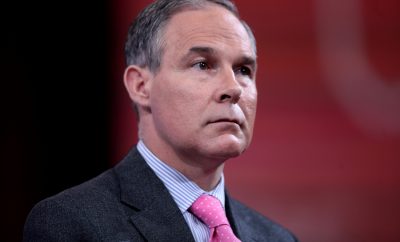 "Moon Rise Behind the San Gorgonio Pass Wind Farm" courtesy of Chuck Coker; License: (CC BY-ND 2.0)
"Moon Rise Behind the San Gorgonio Pass Wind Farm" courtesy of Chuck Coker; License: (CC BY-ND 2.0)
Energy & Environment
The Impact of Environmental Regulations on the Energy Market
One of Donald Trump’s first moves as president was announcing his plan for the imminent repeal of 75 percent of federal regulations. In a previous article, we went over the creation of the Environmental Protection Agency and the ways in which federal environmental regulations affected business growth, outsourcing, and public health costs. Reviews of environmental regulations show that they have saved trillions of dollars in public heath costs while having a modest effect on American business, which has continued to grow and thrive since the creation of the Clean Air Act and Clean Water Act. Removing environmental regulations will likely not be the deciding factor that enables manufacturing to return to America but it could seriously endanger our water and air, especially for poor and at-risk communities.
But the question of what effect regulations have on the energy market itself has been a hot topic of debate lately. Conservative interests have argued for some time that environmental regulations place serious handicaps on fossil fuels and unfairly favor renewables, and the Obama Administration’s Clean Power Plan has come under a storm of criticism for strengthening this dynamic. Read on to learn about federal energy policy and environmental regulations to see how they have historically impacted different energy industries and examine what the Clean Power Plan would have done in contrast to what Trump’s proposed policies will likely do.
Regulations and the Energy Market: Renewables vs. Fossil Fuels
A central objection to environmental regulations is that they unfairly skew the energy market. They place countless handicaps on fossil fuel companies and allow renewables full freedom to prosper, unfairly impacting business throughout the country. It is very true that the energy market is subject to unfair business handicaps, but those that are in place overwhelmingly favor fossil fuel companies rather than hinder their success. Much of this dates back to the Energy Policy Act of 2005, which determined subsidies for different energy sources. The law allocated $5.6 billion in incentives for the gas, oil, and coal industries, $4.5 billion for renewable and alternative energy sources and $3 billion in electricity incentives that largely addressed nuclear power (another $1.3 billion went to energy efficiency and conservation research and development, which mostly applied to fossil fuel production). This $4.5 billion may seem substantial and it did, in fact, bring forth the creation of critical incentives, such as solar tax credits. However, a review of the 2007 budget shows that more than two-thirds of all these renewable subsidies went to ethanol and biofuels. Only a little over a billion dollars went directly into America’s three dominant clean energy sources: solar, wind, and hydropower.
While direct funding and incentives are slanted toward fossil fuels, the real imbalance comes in the form of large-scale post-tax subsidies for fossil fuels that involve the costs of the externalities they create in the form of environmental damage and public health effects. Globally, the subsidy imbalance is extremely dramatic: worldwide about $120 billion in pre-tax subsidies goes to renewables and $523 billion goes to fossil fuels. But when you add post-tax subsidies, the IMF calculates that the fossil fuel industry received a staggering $4.2 trillion in subsidies in 2011. The United States is the world’s top producer of gas and petroleum and it’s a stretch of the imagination to claim that those industries are getting marginalized or cut an unfair deal.
The first part of this series explained the regulations that were placed on power plants for emissions and dumping, which represented a relatively small industry cost (especially compared to the massive public health savings generated by those regulations) and did nothing to stop the growth of the fossil fuel industry. For the most part, renewable energy systems don’t deal with regulations that affect emissions and toxic dumping because they don’t create waste streams through energy production. However, this doesn’t mean that renewables are given a free ride to prosper in the energy market; they are subject to extensive regulatory processes as well despite the fact that they do not have the same adverse impact on public health. The installation of a wind turbine, for instance, requires permits from a vast number of different regulatory authorities, and if even one of the required organizations doesn’t grant a permit then a project can be killed.
A great deal of attention has been called to the potential damage renewables can inflict on wildlife (the most common narrative is that wind turbines kill birds), despite the fact that fossil fuels do much greater damage to wildlife, and protected species regulations are often used to oppose renewable projects. Renewable energy systems can and have been repeatedly shut down mid-project for causing even minor habitat damage. The $2.2 billion BrightSource Solar Farm in the Mojave Desert, the largest solar facility ever to be built in the United States, was almost completely abandoned because of the death of a single endangered desert tortoise.
Fossil fuel companies must deal with some land and water regulations as well, but they also have access to a variety of unique legislative loopholes that allow them to dodge critical regulations and benefit from the tax code–in effect, giving them permission to pollute so that their business may thrive. The most dramatic example of this is the “Halliburton loophole,” which gives hydraulic fracturing companies special permission to inject hazardous chemicals underground, in what would normally be a direct violation of the Safe Drinking Water Act of 1974. These benefits extend to the basic permitting processes that different energy companies must go through as well: fossil fuel companies generally have a streamlined permitting process, are given the cheapest land leasing rates, and must provide no strategy or evaluation of environmental safety.
In California, for instance, a solar farm project can require a three-year permitting process that requires millions of dollars. Comparatively, a fossil fuel company needs only a one-page declaration of intent and can begin construction almost immediately. Furthermore, the Bureau of Land Management values the land it leases to oil and gas companies at a rate set almost a century ago, meaning these companies pay incredibly low prices when utilizing federal land (costing $30 billion in federal revenue over the last 30 years for undervalued land) while the BLM requires renewables to pay modern land leasing rates. The idea that the fossil fuel industry is unfairly suppressed by regulation is a myth; the fossil fuel industry already has access to numerous regulatory loopholes and subsidy benefits. The environmental regulations that are in place aren’t suffocating growth, they’re providing critical protection for our public health against industries with high pollution potential.
Regulations and the Energy Market: The Coal Industry
The fossil fuel source that does face serious decline is coal, which the Clean Power Plan specifically targeted as the most dangerous energy source in use, both for climate change and for public health. One of Trump’s favorite mantras during his campaign was that regulations have destroyed the coal industry and taken away countless jobs from Americans in the process. Historically, no such pattern has been observable; the coal industry prospered under environmental regulations for decades and has suffered so much in recent years largely because of competition with the massive spike in domestic natural gas production and usage. This makes President Trump’s claim that he will boost both coal and gas production–which are two directly competing industries–particularly confusing. Critics of environmental regulations generally point to the implementation of the Mining Safety and Health Administration’s 2014 Respirable Coal Mine Dust Rule, which decreased acceptable concentrations of coal dust per cubic meter from 2 grams to 1.5 grams and required regular air samplings to be taken. This legislation has been a hot topic among the anti-regulation community and coal advocates have complained that maintaining such low levels are unfairly difficult at existing output levels.

Image courtesy of Greg Goebel; License: (CC BY-SA 2.0).
However, it’s worth noting that the rule was put in place in 2014, long after American business made the decision to favor natural gas and long after the initial downturn of the coal industry. It’s also true that the rule addresses very legitimate health concerns and when evaluating the efficacy of a regulation it is important to compare the health benefits to the cost savings that would disappear if the rule were rescinded. A staggering 76,000 miners have died from black lung over the last 50 years. Over the same time frame, the government has had to pay out $45 billion in federal compensation to affected workers and their families. The law is also directly targeted at mining crews with Part 90 miners–workers who have already been diagnosed with a respiratory illness. The rule sought to protect the most at-risk population of workers and if the coal industry is to have a productive workforce then it has a responsibility to ensure the health and survival of that workforce. Estimated annualized compliance costs were about $28.1 million at a 7 percent discount rate, with the majority of compliance costs coming from tech purchases for the newly required Continuous Personal Dust Monitors. This number may seem huge but it only represents about 0.13 percent of the coal industry’s annual earnings of $20.2 billion and less than a third of the $1 billion our nation pays out each year in federal compensation to sick and dying miners.
As an energy source, natural gas simply provides more energy for a lower cost, making it unlikely that coal will experience a serious resurgence in the United States. The coal industry survived and grew under the Clean Air Act, and the industry was on its way out long before the Respirable Coal Mine Dust Rule came into effect. While it’s highly likely that the Clean Power Plan would deal a deathblow to the industry, increasing funds to gas as Trump plans will accomplish the same thing only just at a slower rate.
Repealing pollution regulations like safeguards and filter requirements and removing coal mine dust restrictions wouldn’t make the changes necessary to revive the weakening business, not as long as gas is abundant and comparatively cheap. Removing these regulations would, however, make the coal production and disposal process more dangerous for the environment and miners would be the first group to experience the health consequences.
Obama vs. Trump
The Clean Power Plan issued new carbon emissions reductions standards for each state and would have required the states to independently create a plan to meet their target goals. The result would have been a huge increase in clean, renewable energy production. Coal would have been hit the hardest by this as the worst polluter, although the natural gas industry would more easily be able to improve efficiency rates and meet the new standards. The CPP actually encourages the increased use of gas, as long as it’s primarily a replacement for coal.
The nature of this policy aligns with public opinion as well. About 65 percent of the population favors stricter emissions regulations, about 70 to 75 percent of Americans want to see increased renewable energy, and only about 30 percent want to see more coal. However, the coal industry represents 174,000 jobs, including extraction, transportation, and production and it is unfair to cut off employment without generating new opportunities, even if those lost jobs had high health risks.
However, the Clean Power Plan has a strong focus on creating jobs in renewable energy and pollution control industries. The traditional conservative narrative claims that fossil fuels create employment and clean energy policies stifle it, but the reality is actually the reverse; renewables can be a vital catalyst for job growth and actually create more jobs than fossil fuels. One powerful example of the over-inflated projections of fossil fuel employment opportunities is happening right now, with President Trump advancing the Dakota Access Pipeline and Keystone XL Pipeline. The Keystone Pipeline, in particular, has come under a media firestorm after it was revealed that the project would only create 35 permanent jobs. Like most construction projects, the vast majority of jobs related to the pipeline will be temporary positions, including some that will only last for a few months or “spillover jobs” that take place in another industry.
The entire clean energy sector employed 8.1 million workers as of 2015 and growth in the sector has also moved at a rate 12 times faster than overall job growth. In 2014 there were 7.7 million clean energy jobs worldwide and by the end of 2015, that number had grown to about 8.1 million. The related job creation is also remarkable when compared to fossil fuels–a million dollars of spending on renewable energy and energy efficiency will create 13 jobs. That same million dollars only creates 6 jobs within the fossil fuel industry. These are good jobs for middle-class Americans as well, paying on average 13 percent higher than median wages. Many of the jobs that are created by renewable energy involve manufacturing, which would align with President Trump’s vow to revitalize the American manufacturing industry. However, unlike fossil fuels, positions in the renewable energy industry don’t endanger the health of the workers who support them. Hillary Clinton’s ambitious Clean Power Challenge would have expanded upon Obama’s CPP and would have increased renewables through competitive grants, tax incentives, and market-based incentives and created a flux of new jobs in the process. Such efforts would have also meant opening up the industry of offshore wind, a massive and untapped source of domestic energy and employment.

“Keystone XL Pipeline Protest at White House” courtesy of Tar Sand Action; License: (CC BY 2.0)
Critics of the Clean Power Plan claimed that it unfairly supported renewables and made it impossible for fossil fuels to thrive. It’s more accurate to say that it would have leveled the playing field, not skewed it in favor of renewables. Fossil fuels would still be disproportionately subsidized and would still play a huge role in American energy. What the CPP would have done is act as a major catalyst for an increase in clean energy use that America needs to combat climate change, establish energy independence, protect our public health and national lands, while creating new jobs for Americans.
Conclusion
It’s a political myth that the fossil fuel industry is unfairly regulated in the United States. America produces more gas and petroleum than any country on earth, subsidizes the fossil fuel industry with billions more than goes to renewables, and gives oil and gas companies fast-track access to land at the cheapest possible rates. The Clean Power Plan was a chance to increase clean, domestic renewable energy across the nation. Without the plan, the state renewable energy goals will be rendered non-binding and the progress of renewables will move at a much slower rate. Over the next four years, America will continue to be dependent on fossil fuels as the Trump Administration works to open up federal lands for drilling and fracking and peel back regulations allowing the oil and gas industry to freely pollute.
Will a Donald Trump presidency destroy the renewable energy industry? No, because the president doesn’t truly have control over the free market. Trump can seriously slow down renewable progress, but even if the Clean Power Plan is reversed, 29 states still have Renewable Target Portfolios established and another eight have created non-binding goals for themselves. The renewable energy industry has grown dramatically and will continue to receive bipartisan support in the places where it is cost efficient and useful. Red states such as Idaho, the Dakotas, and Texas have all made serious commitments to renewables because they have high renewable energy potential and investing in solar and wind simply makes economic sense. Technological improvements, especially within the field of energy storage, are increasingly raising the value of renewable energy systems and boosting growth within the private sector. In terms of coal, it will be difficult, and maybe even impossible, to bring the coal industry back to its previous rates of production as long as natural gas thrives in the United States.
However, climate change worsens every year and we don’t really have the luxury of waiting for things to move slowly. With Trump in power not only will much of Obama’s work be undone, we will also lose out on one of our last chances as a nation to try and combat climate change.








Comments